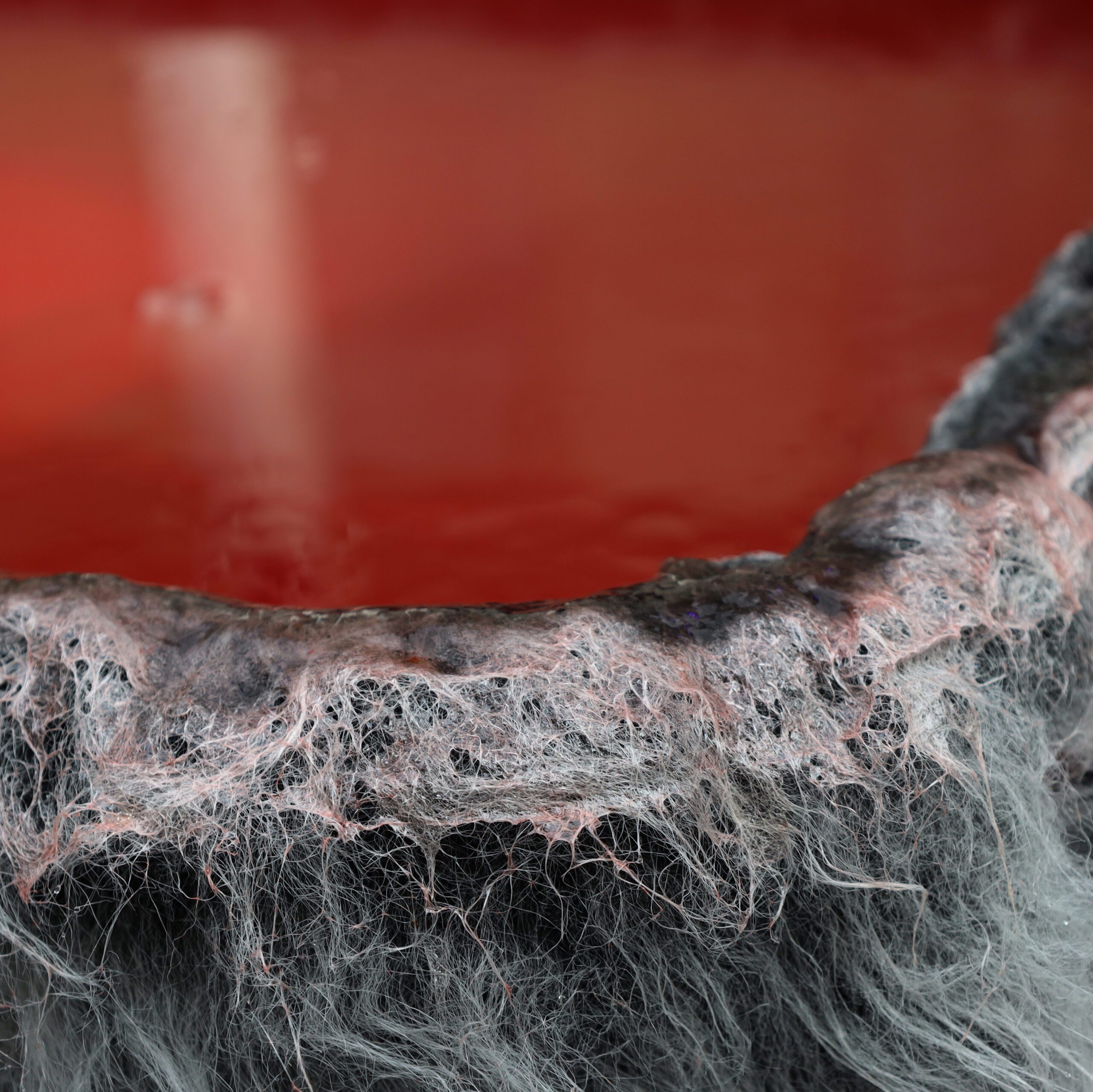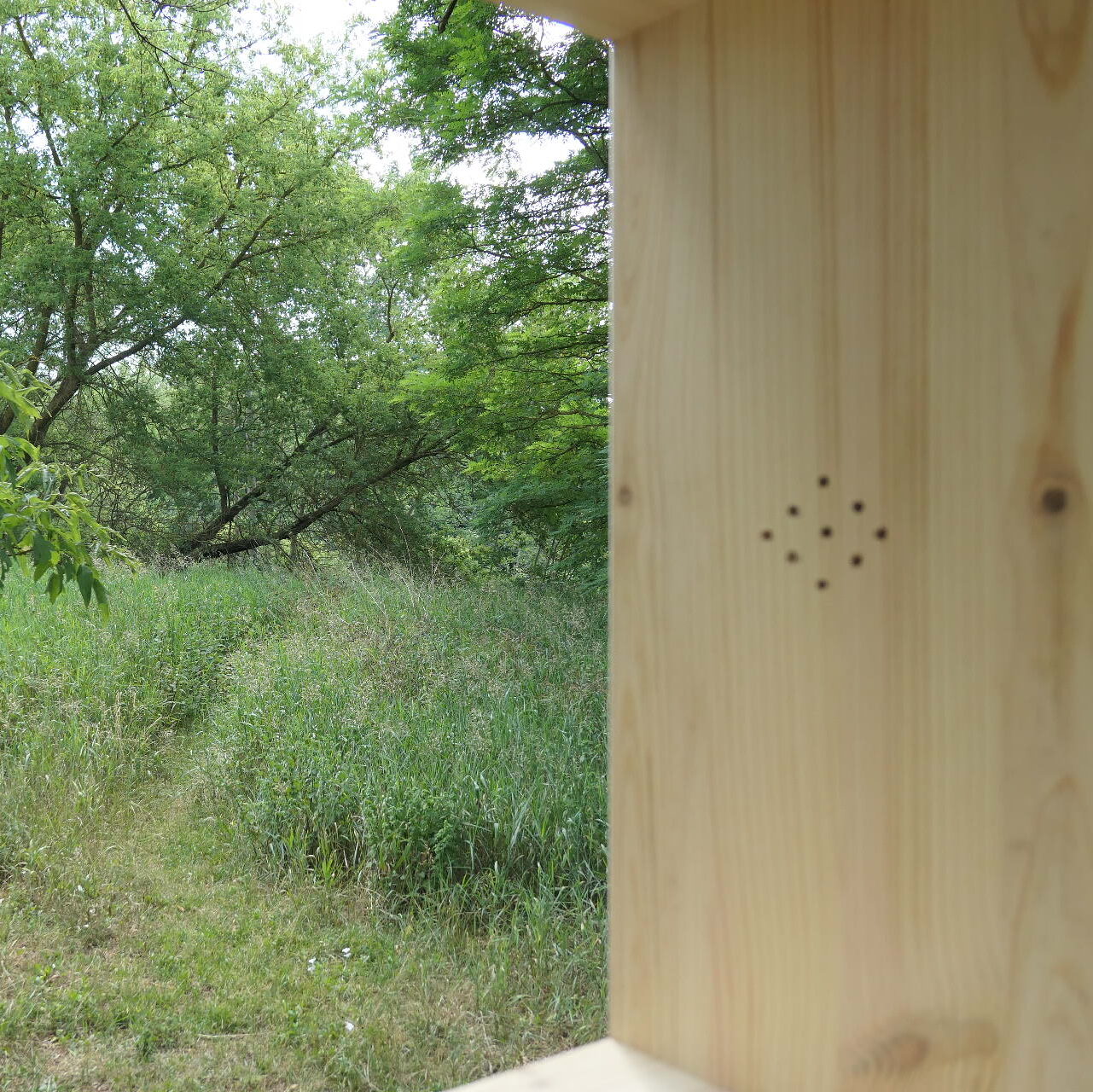Secretion (2023)
Singing fountain of bodily fluids.
Can it be that in the West, in our time, the female body (sigh) has been constructed not only as a lack or absence but with more complexity, as a leaking, uncontrollable, seeping liquid; as formless flow; as viscosity, entrapping, secreting; as lacking not so much or simply the phallus but self-containment—not a cracked or porous vessel, like a leaking ship, but a formlessness that engulfs all form, a disorder that threatens all order?
Grosz, E. Volatile Bodies : toward a Corporeal Feminism. Bloomington (Indiana University Press, 1994), 203.

Mixing fluid choreography, haptics and multichannel composition, Secretion is a sound installation taking the form of a slime fountain. Inspired by the baroque water features of the 18th century in Versailles, it proposes a reflection on our relation to menstrual bloods and body fluids. Away from flamboyant representations of Man’s power on nature, it tackles menstruation with a materialistic and genderless approach.

The abject and monstrous present in us to become unavoidable and fascinating when erupting in the room. Visitors are compelled to drift away from the usual anthropological connotations of menstrual blood and embrace it all: sounds, smells, texture…
A watery body sloshes and leaks, excretes and perspires. Its depths gurgle, erupt. A body of water also extends, transcorporeally, into other assemblages: watershed, cistern, sea; and other bodies that are human, vegetable, animal, and hydrogeological.
Inspired by the ideas of Astrida Neimanis, Secretion addresses the intertwinement of our own biological waters with all planetary fluids. De-centering ourselves as human, we could embrace our raw materiality as part of an entire ecosystem. The slime, composed of sodium alginate – a natural brown seaweed extract – is subject to osmosis, becoming stickier and darker with time. While Neimanis wrote her book before the Covid-19 Pandemic, we can only witness how accurate her idea of the porosity of our organisms as a link to all others entities and environment.
These varied speeds and slownesses, multiple movements, and diverse incorporations of ‘water’ belie the difficulty of speaking of water in the abstract – as though it were one undifferentiated and amorphous thing, the same everywhere and all the time. But, undeniably, this is all water. We are all bodies of water. In fact, paying attention to hydrological cycles presents a rather queer notion: water is evidently both finite and inexhaustible; both the same and always becoming different, too.
Neimanis, A. Bodies of Water: Posthuman Feminist Phenomenology. (London: Bloomsbury Academic, 2016), 46


stereo version of the 4.1 soundtrack
Through a genderless voices soundtrack synchronized with water pumps, Secretion invites visitors to imagine the liquid as its own creature. Words initially understandable lose intelligibility and evolve as a slimy entity. The slime falling back from the pumps creates its own very soundscape unique to each cycle, and due to the very nature of water, spillage of it around the fountain is inevitable. It splashes the visitors, ends up on the floor, the fabric, or evaporates, reshaping the sculpture through time. Secretion act as a permanent exchange of molecules, an invitation to consider other scales of organisms, other realities, other materialities.
Grosz, E. Volatile Bodies : toward a Corporeal Feminism. Bloomington (Indiana University Press, 1994).
Neimanis, A. Bodies of Water: Posthuman Feminist Phenomenology. (London: Bloomsbury Academic, 2016).


Secretion was presented at the Menstrualities exhibition at Alte Munze, Berlin
Cybernetic Booth (2022)
Failure of the cybernetics
Sound installation in the frame of the exhibition Sprache im technischen Zeitalter at the TU & UdK Universitätsbibliothek in Berlin, a cooperation of UdK’s Sound Studies and Sonic Art Program with the TU Stage Design Master’s program, and the TU Litterature Studies program.
Design by Siwei Cai & Nikolai Korypaev . Sound by Salomé Lubczanski & Makoto Oshiro.
From the life and work of Walter Hollerer, tainted by a fascist history, emerged a concept of cybernetics. This concept, given the writer, explores the interactions between living organisms and machines, in interdisciplinary and complex systems. By exploring feedback loops and control mechanisms, cybernetics search to understand and improve the communication.
This cybernetic booth aims to interrogate the relevance of this concept. The installation reveals the power of machines and systems to obstruct and distort communication, leading to the impossibility of mutual understanding.


The cabin welcomes visitors with a cacophony of fragmented voices, falling silent when a newcomer picks up the phone receiver, as to premeditate the failure of the machine. Each press of the phone’s keypad is programmed to play a rendition of the Hollerer’s poem Der Fremde unserer Stadt (1958) in a different language. The text, subject to multiple translations in a feedback loop, loses its original meaning. The translation cycle defeats its own purpose and reveals a collection of nonsentences. As the sentences drift away from intelligibility, the listener is left only with the sonic and textural qualities of words. Here, the machine transitions to an obstacle to clear communication and mutual understanding.



All photo by © Christian Kielmann, www.herr-kielmann.de
The installation serves as a poignant reminder of the invisible dangers inherent in unchecked technological progress and the potential for manipulation and control. By subverting Hollerer’s utopian vision of cybernetics, the Cybernetic Booth prompts reflection on the complexities of human interaction and the ethical implications of technological advancement.
Thirsty (2022)
Multi-sonic window for a Mensch-made landscape.

The Klanglandschaften Festival is organised on the Holbrechter Riesenfelder, where used waters from Berlin were transported and cleaned from 1871 till 1985. Treated waters were initially re-used for local agricultural production but the growing industrialisation brought increasingly polluted waters. Today many heavy metals, anionic agents and hydrocarbons are laying invisible in the grounds, making it unsuitable for any agricultural work. In recent years, the fields have been reforested, reshaped, and repopulated. They serve now as a leisure park and research laboratory for landscaping and forest development.
To raise awareness on water pollution and human intervention on the landscape, Durstig is built as a sonic window which the visitor can look through, hear through and touch. It invites the listener to contemplate the human shaped nature while listening to the unseen. Each side of the window plays a different arrangement of underwater recordings and algorithmic composition based on the heavy metals present in the ground.
Durstig hangs from a maple tree next to a pond, planted especially to reduce the spread of polluted waters. Acting as a gatekeeper, the tree uses the neighbouring water for its growth and keeps it from streaming further.


video by © Jan Thoben
Thristy was installed at the Klanglandschaften Festival 2022 in the Holbrechtfelder, Brandenburg.
Hey Bitch ! (2021)
Vibrating chair to upcycle cat calling.

Following Henry Lefebvre’s ideas, urban space is not simply an inanimate place filled by people. It is conceived, perceived and lived, therefore dependent from social dynamics and political contexts. Who does the city belong to? Who is free to walk the streets? Today, city soundscapes feature endless street harassment. It targets physical bodies and resonates in mental spaces.
Hey bitch! invites the audience to sit down, re-appropriate their body and reflect on its place in the city.
The chair is made of recycled palette wood to integrates perfectly the urban space and transmits the deep vibrations to the listener’s body.
The soundtrack is composed of common verbal catcalling insults, such as “bitch”, “slut”, redesigned and recycled as a healing sonic massage. How does your body resonate to this? How do you reclaim your space?




Hey Bitch! was presented at The Sounds About 2022 exhibition at Zwitschermachine, Berlin
Trash Talk (2021)
Sonic shredder to celebrate the destruction of your administration paperwork.




Trash Talk was exhibited at The Sounds About 2022 exhibition in Zwitschermachine, Berlin
- Aucune catégorie





